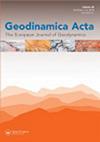土耳其西北部卡拉卡贝地区西Sakarya带泥盆纪岩浆活动
IF 1.5
Q1 Earth and Planetary Sciences
引用次数: 41
摘要
卡拉卡贝岩体是位于土耳其西北部的一个大型岩浆岩体,由下卡拉卡亚杂岩的三叠纪变质岩组成。变质岩和卡拉卡贝岩体均被下侏罗统和更年轻的沉积层序不整合覆盖。根据前人的K-Ar黑云母年代学资料,认为卡拉卡贝岩体属于石炭纪侵入岩。在这里,我们提供了来自卡拉卡贝岩体的新的地质、地球化学和年代学数据。两个样品的锆石U-Pb年龄分别为393.8 +/−2.7 ~ 395.9 +/−4.09 Ma,表明花岗岩类侵入地壳的时间为早-中泥盆世。卡拉卡贝岩体主要由黑云母和局部含角闪石的花岗类组成,少量为s型白斑花岗闪长岩,均为伟晶岩体切割。它属于高钾钙碱性系列,在多元素蜘蛛图上具有明显的Nb和Ta异常。Sr和Nd同位素的初始值分别为0.709 ~ 0.712和0.511 ~ 0.512。εNd(i)值在−7.8 ~−9.4之间。岩石的同位素特征表明下地壳源区既有变质岩源,也有变质岩源。岩石的地球化学特征表明,它们与土耳其西北部比加半岛的其他泥盆纪花岗岩类一起发育在与弧相关的环境中。花岗岩类具有低温蚀变/变质作用,石英重结晶,长石绢云母化,形成晚绿泥石、绿帘石和白云母。可能由于这些原因,Ar-Ar黑云母年龄分散,可能集中在二叠纪-石炭纪边界附近。锆石(U-Th)/He年代学表明,早侏罗世—早白垩世沉积期花岗岩类被重新埋没后,晚白垩世(Turonian)再次隆升侵蚀,这可能与北部塘内洋的闭合有关。本文章由计算机程序翻译,如有差异,请以英文原文为准。
Devonian magmatism in the western Sakarya Zone, Karacabey region, NW Turkey
The Karacabey Pluton is a large magmatic body in the northwestern Turkey overthrust by the probable Triassic metamorphic rocks of the Lower Karakaya Complex. Both the metamorphic rocks and the Karacabey Pluton are unconformably overlain by a Lower Jurassic and younger sedimentary sequence. The Karacabey Pluton was regarded as a Carboniferous intrusion based on the previous K-Ar biotite geochronological data. Here, we provide new geological, geochemical and geochronological data from the Karacabey Pluton. Zircon U-Pb results from two samples yielded ages of 393.8 +/−2.7 to 395.9 +/−4.09 Ma, suggesting that the granitoids intruded in the crust throughout the Early to Middle Devonian. The Karacabey Pluton consists mainly of biotite and locally hornblende bearing granitoid with lesser amounts of S-type leucocratic granodiorite, all of which are cut by pegmatitic bodies. It belongs to the high-K calc-alkaline series with distinct Nb and Ta anomalies in multi-element spider diagram. Sr and Nd isotopes’ initial values are 0.709–0.712 and 0.511–0.512, respectively. εNd(i) values range between −7.8 and −9.4. The isotopic characteristics of the rocks indicate lower crustal sources of both metapelitic and metaigneous origin. Geochemical features of the rocks suggest that they developed in an arc-related environment, along with the other Devonian granitoids described from the Biga Peninsula in northwest Turkey. The granitoid shows a low-temperature alteration/metamorphism marked by recrystallization of quartz, sericitization of the feldspar and formation of late chlorite, epidote and muscovite. Possibly because of these, the Ar–Ar biotite ages are scattered with a possible concentration at around Permo–Carboniferous boundary. Zircon (U-Th)/He geochronology suggests that after the granitoid was reburied during Early Jurassic to Early Cretaceous sedimentation, there was renewed uplift and erosion during the Late Cretaceous (Turonian), which is possibly related to the closure of the Intra-Pontide Ocean in the north.
求助全文
通过发布文献求助,成功后即可免费获取论文全文。
去求助
来源期刊

Geodinamica Acta
地学-地球科学综合
CiteScore
4.50
自引率
0.00%
发文量
0
审稿时长
25 weeks
期刊介绍:
Geodinamica Acta provides an international and interdisciplinary forum for the publication of results of recent research dealing with both internal and external geodynamics. Its aims to promote discussion between the various disciplines that work on the dynamics of the lithosphere and hydrosphere. There are no constraints over themes, provided the main thrust of the paper relates to Earth''s internal and external geodynamics. The Journal encourages the submission of papers in all fields of earth sciences, such as biostratigraphy, geochemistry, geochronology and thermochronology, geohazards and their societal impacts, geomorphology, geophysics, glaciology, igneous and metamorphic petrology, magmatism, marine geology, metamorphism, mineral-deposits and energy resources, mineralogy, orogeny, palaeoclimatology, palaeoecology, paleoceanograpgy, palaeontology, petroleum geology, sedimentology, seismology and earthquakes, stratigraphy, structural geology, surface processes, tectonics (neoteoctonic, plate tectonics, seismo-tectonics, Active tectonics) and volcanism.
Geodinamica Acta publishes high quality, peer-reviewed original and timely scientific papers, comprehensive review articles on hot topics of current interest, rapid communications relating to a significant advance in the earth sciences with broad interest, and discussions of papers that have already appeared in recent issues of the journal. Book reviews are also included. Submitted papers must have international appeal and regional implications; they should present work that would be of interest to many different specialists. Geographic coverage is global and work on any part of the world is considered. The Journal also publishes thematic sets of papers on topical aspects of earth sciences or special issues of selected papers from conferences.
 求助内容:
求助内容: 应助结果提醒方式:
应助结果提醒方式:


